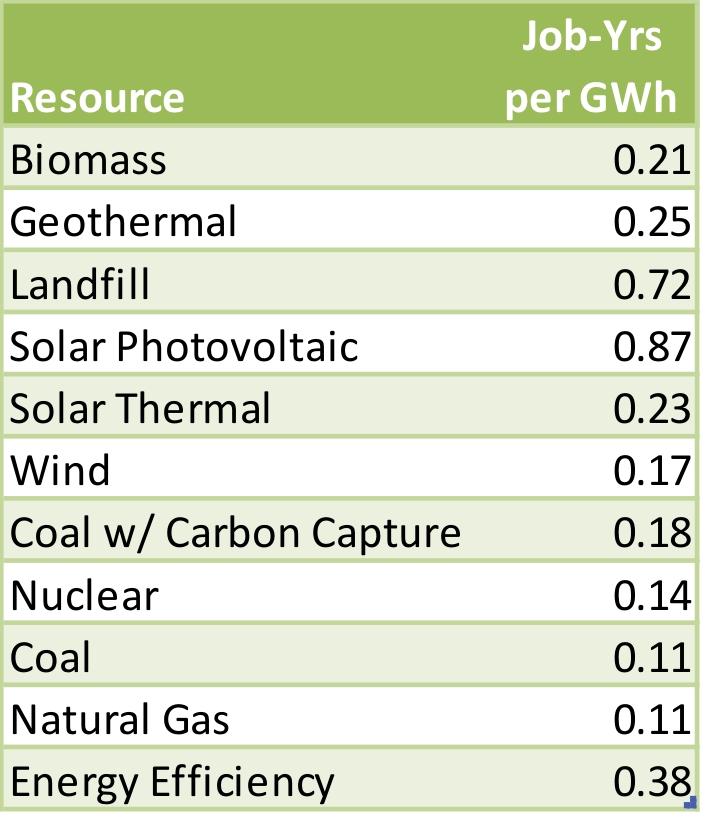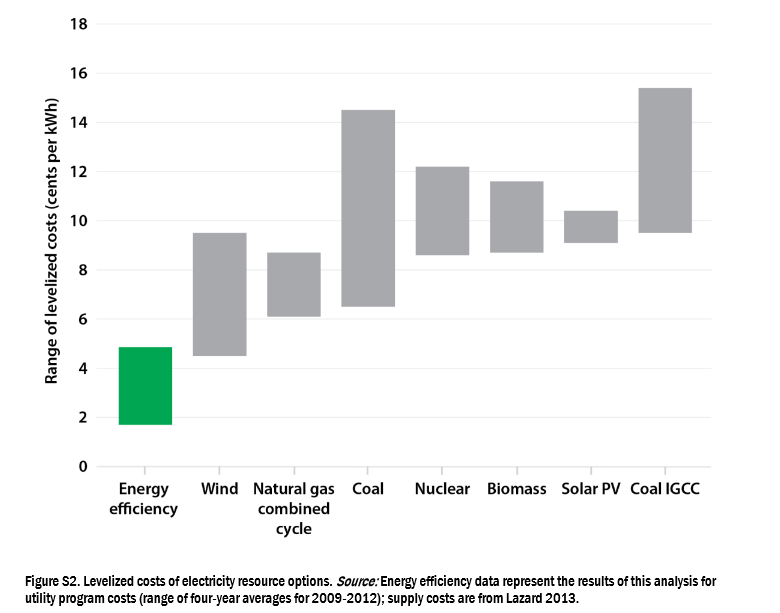

Last week’s post ended with a suggestion to use a benefit/cost metric like that produced by ACEEE, shown in the chart. The results of ACEEE’s study indicate that energy efficiency is the cheapest resource for “producing” energy. As long as it is the cheapest source, let’s keep buying.
The regulated utility business is weird. The energy efficiency business is off-the-chart weird. Why? Because we produce the ballyhooed tawagem[1]. We produce a lack of something. Nothing. A vacuum. We save energy at a lower cost per kWh than it costs to generate a kWh, with anything.
So, what does this mean? How does this benefit anyone? Who is buying these tawagem-hours for $30? Nobody. This is disturbing to me, but I’m a rationalizing philosopher at heart. Therefore, I rationalize that saving energy with widgets and minimizing system waste with our brains is cheaper than producing power. We are essentially replacing brawn – just add more supply – with brains and activity. How does this look from a jobs perspective?
Speaking of philosophy, jobs are a weird thing too. Heard anything about jobs in political campaigns lately? Job creation indicates the economy is growing, it would seem. Not really. Gross domestic product growth means the economy is growing. The private sector constantly evolves to be as productive as possible. Productivity often means automation. Automation means lost jobs. Technology has displaced millions of jobs: toll takers, bank tellers, cashiers, call centers (think purchasing plane tickets and booking hotel rooms), farming, fast food, and manufacturing across the board, to name a few.

So, energy efficiency again is backward. As producers of the tawagem, we use more labor than the power supply business with comparably enormous generating systems that also gobble up resources. More simply (see formula to the left):
I am text block. Click edit button to change this text. Lorem ipsum dolor sit amet, consectetur adipiscing elit. Ut elit tellus, luctus nec ullamcorper mattis, pulvinar dapibus leo.
Researchers at Cal Berkeley aggregated and analyzed jobs data from various supply and demand reduction (energy efficiency) resources. Jobs data are easy to spin because there are primary and secondary jobs impacts and net effects. The paper describes three types of jobs resulting from any industry: direct, indirect, and induced.
Caterpillar creates direct jobs in Peoria Illinois to build its earth-moving equipment. Its earth-moving equipment is shipped to Australia where it is used to mine ore. The ore is shipped to China where it is manufactured into steel. The steel is shipped to Peoria where it is manufactured into earth movers. This is a true story. According to the Berkeley paper, the jobs in the steel plant in China would be indirect jobs. Those in Australia are also indirect jobs. Service jobs to fly, lodge, and feed people involved are induced jobs. I was pleased to see the researchers took this into account. I want the whole story, although the further away from the direct job, the fuzzier and more difficult things get.
Everyone reading this likely owes all or at least some of their employment to energy efficiency. Utility DSM staff, consultants, software, hardware, and equipment manufacturers, and regulatory staff are fully or partly dependent on energy efficiency. Even utility account management spending 10-20% of their time on energy efficiency would require fewer heads if there were no energy efficiency. Indirect jobs would include manufacturers of lighting, controls, and equipment.
Likewise on the generating side, there is direct employment with construction of generating assets, transmission and distribution. There are also direct jobs with the operations and maintenance of the same systems. Indirect jobs again include those for manufacturing, power generating, transmission and distribution equipment, and also coal producers, railroad companies, and raw material (e.g. conductors) producers.







Jeff – I think these numbers are contradicting each other. Maybe something is left out, like commodity fuel costs? Less jobs per GWh would imply, especially in mature industries, that something costs less per GWh, because the primary cost of anything is split between two things – labor (even commodities are priced based somewhat on the labor needed to extract them) and the scarcity of the commodity itself. If labor costs alone are compared, less jobs per GWh is actually the goal in order to make the EE cost lower. Further, whatever the assumptions, some measure of the induced and indirect jobs from an activity are likely to be missed or miscalculated. Can’t we just go to the price we had originally? That has it all in there, one way or another, because everyone in the chain isn’t working for free, so the knowledge problem, as it’s called in Austrian Economics is already solved for us. No need to make it more complicated than what’s already been done for us by the market price.
Thanks Nick. You are correct – from an economic standpoint, EE is best, at least per ACEEE. My wonder was, how does this work from a jobs and materials perspective? I was thinking (guessing) that EE requires more labor per kWh, but even with more labor per kWh, the material cost savings, including commodity cost savings (EE vs added supply) more than make up for the extra labor costs of EE.
Therefore, according to these studies, we get the best of both worlds – more jobs, and a lower cost resource.
Hope this makes sense.